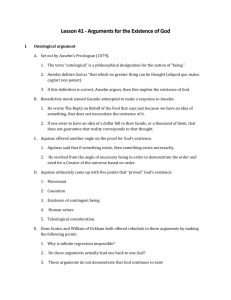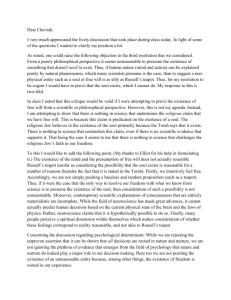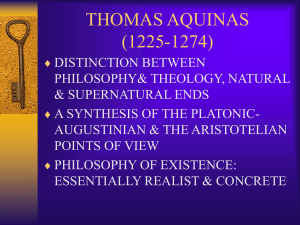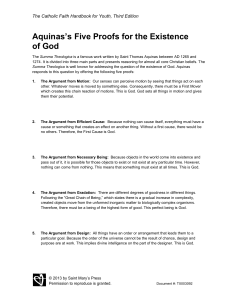Introduction to Part II: Philosophy of Nature
advertisement
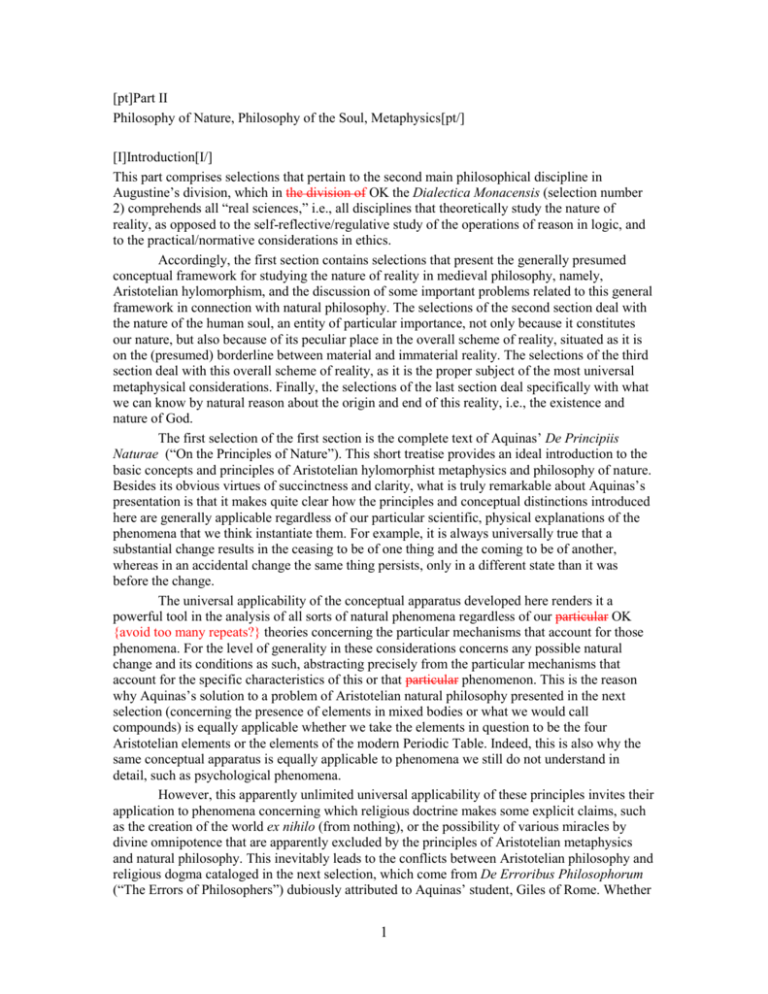
[pt]Part II
Philosophy of Nature, Philosophy of the Soul, Metaphysics[pt/]
[I]Introduction[I/]
This part comprises selections that pertain to the second main philosophical discipline in
Augustine’s division, which in the division of OK the Dialectica Monacensis (selection number
2) comprehends all “real sciences,” i.e., all disciplines that theoretically study the nature of
reality, as opposed to the self-reflective/regulative study of the operations of reason in logic, and
to the practical/normative considerations in ethics.
Accordingly, the first section contains selections that present the generally presumed
conceptual framework for studying the nature of reality in medieval philosophy, namely,
Aristotelian hylomorphism, and the discussion of some important problems related to this general
framework in connection with natural philosophy. The selections of the second section deal with
the nature of the human soul, an entity of particular importance, not only because it constitutes
our nature, but also because of its peculiar place in the overall scheme of reality, situated as it is
on the (presumed) borderline between material and immaterial reality. The selections of the third
section deal with this overall scheme of reality, as it is the proper subject of the most universal
metaphysical considerations. Finally, the selections of the last section deal specifically with what
we can know by natural reason about the origin and end of this reality, i.e., the existence and
nature of God.
The first selection of the first section is the complete text of Aquinas’ De Principiis
Naturae (“On the Principles of Nature”). This short treatise provides an ideal introduction to the
basic concepts and principles of Aristotelian hylomorphist metaphysics and philosophy of nature.
Besides its obvious virtues of succinctness and clarity, what is truly remarkable about Aquinas’s
presentation is that it makes quite clear how the principles and conceptual distinctions introduced
here are generally applicable regardless of our particular scientific, physical explanations of the
phenomena that we think instantiate them. For example, it is always universally true that a
substantial change results in the ceasing to be of one thing and the coming to be of another,
whereas in an accidental change the same thing persists, only in a different state than it was
before the change.
The universal applicability of the conceptual apparatus developed here renders it a
powerful tool in the analysis of all sorts of natural phenomena regardless of our particular OK
{avoid too many repeats?} theories concerning the particular mechanisms that account for those
phenomena. For the level of generality in these considerations concerns any possible natural
change and its conditions as such, abstracting precisely from the particular mechanisms that
account for the specific characteristics of this or that particular phenomenon. This is the reason
why Aquinas’s solution to a problem of Aristotelian natural philosophy presented in the next
selection (concerning the presence of elements in mixed bodies or what we would call
compounds) is equally applicable whether we take the elements in question to be the four
Aristotelian elements or the elements of the modern Periodic Table. Indeed, this is also why the
same conceptual apparatus is equally applicable to phenomena we still do not understand in
detail, such as psychological phenomena.
However, this apparently unlimited universal applicability of these principles invites their
application to phenomena concerning which religious doctrine makes some explicit claims, such
as the creation of the world ex nihilo (from nothing), or the possibility of various miracles by
divine omnipotence that are apparently excluded by the principles of Aristotelian metaphysics
and natural philosophy. This inevitably leads to the conflicts between Aristotelian philosophy and
religious dogma cataloged in the next selection, which come from De Erroribus Philosophorum
(“The Errors of Philosophers”) dubiously attributed to Aquinas’ student, Giles of Rome. Whether
1
or not it is the authentic work of Giles, the systematic presentation, useful summaries of the main
doctrinal points criticized, and their reduction to their principles make this short treatise a
particularly useful source for studying the doctrinal conflicts of the period. The selection in this
volume only reproduces the critique of Aristotle, Avicenna, and Averroes (although the complete
work also deals with Algazel, Alkindi, and Maimonides).
However, the most important document of the “official reaction” to these conflicts is still
the text of the 1277 Paris Condemnation, reproduced in part in the next selection. As was has
already been indicated in the General Introduction, the sweeping Condemnation primarily
targeted the radical Aristotelianism of the Latin Averroists, but it also touched on some of the
theses of Aquinas, especially those connected to his conception of matter as the principle of
individuation. The relevant theses of the Condemnation are indicated by an ‘A’ added to their
number in the present selection.
By the late medieval period, Aristotelian physics came to be criticized not only for more
than only theological or arcane metaphysical reasons. The last selection of this section presents
Buridan’s criticism of the Aristotelian principle that motion requires the activity of an actual
mover, which does not appear to be the case in the motion of projectiles (i.e., in cases that we
would characterize in modern physics as inertial motion). Buridan produces a barrage of
arguments against Aristotle’s own solution to the problem (provided in terms of the motion of the
surrounding air), based on keen observation and careful reasoning. Buridan’s own solution, in
terms of the postulation of an impressed force, the so-called impetus, proved to be enormously
influential, up until Galileo’s time. Although this seems to be just a particular problem for
Aristotelian physics, Buridan’s solution has far-reaching implications for metaphysics and natural
theology. For if motion can be present without an actual mover (as it is clearly is the case if its
impetus can move a body long after the mover has let it go), then the existence of motion in the
universe cannot provide evidence for the actual existence and activity of the ultimate source of
this motion. Therefore, Buridan’s impetus theory poses a serious challenge to the Aristotelian
argument for the existence of a prime mover, adapted by many (indeed, practically all) thirteenthcentury theologians and philosophers for proving the existence of God.
The selections of the second section deal with human nature and the human soul. The
brief selections from Augustine are meant to illustrate his Platonic conception of human nature,
according to which a human person is nothing but a soul ruling a human body. That the soul and
body are two distinct entities and a human being is a composite of the two is not something
Augustine feels the need to argue for. As a result, he has to deal with something like the modern,
post-Cartesian “interaction problem,” the problem of how the material body can act on the
immaterial soul (in sense perception), and how the immaterial soul can act on the material body
(in voluntary action). It is quite telling, however, that Augustine only has the “first half” of this
problem: what he finds problematic is only the body’s action on the soul; but the soul’s ability to
move the body is not an issue for him. The reason is that he does not have among his assumptions
the idea of the causal closure of a (mechanistic) physical universe usually assumed in postCartesian thought. After all, for him all physical phenomena are just manifestations of God’s
continuous creative and sustaining activity, and so, just as God rules the material world in the
macrocosm of nature, so does the soul rule its body in the microcosm of human nature. Thus,
voluntary acts are just manifestations of the soul’s power to move the body, just as the movement
of the heavenly bodies is a manifestation of God’s power to move the entire universe. But
perception poses a problem precisely because of this conception of causality in terms of ruling or
dominance. For that which is subordinate in this asymmetrical relation cannot affect that which
dominates it. Augustine’s solution in terms of the soul’s attention required by the resistance of the
body to its rule quite elegantly deals with this problem, but his rather skeletal conception leaves a
great deal of issues OKunanswered. So it is no wonder that after the arrival of Aristotle’s detailed
and sophisticated theory of the soul in general and of the human soul in particular, Augustine’s
2
conception exerted a somewhat oblique influence within a generally Aristotelian conceptual
framework, in the form of Augustinian theologians’ endorsement of the idea of a plurality of
substantial forms in the same individual (i.e., the doctrine that the same individual substance has
several substantial forms; say, in a human person there would be a form accounting for her
corporeal features, such as being extended in space, another one accounting for her vegetative
functions, a vegetative or nutritive soul, another accounting for her sensitive functions, a
sensitive soul, and yet another accounting for her rationality, a rational soul, although some
authors would take only two or three of these to be really distinct from each other).
In the Aristotelian framework, the soul (in Latin, anima) is simply the principle of life:
that which animates any living -- that is, animate -- being. So the soul is that on account of which
a living being is alive. And since for a living being to live is for it to be, absolutely speaking, i.e.,
to have its substantial being, and since that on account of which something has its substantial
being is its substantial form, it follows that the soul of a living being is its substantial form. Note
how this conception can get around the “interaction problem”: since the soul and body are not
two distinct entities acting on each other, but are rather the essential, integral parts of primary
substances (which are the primary agents in causal relations), the question is not what sort of
causal mechanisms can account for the interaction between body and soul; rather, the question
will be what sort of causal powers living bodies informed by their peculiar substantial forms must
have in order to perform their vital functions. So, plant-souls obviously need to have powers for
nutrition, growth, and self-reproduction, more developed brute animal souls must have in addition
powers of perception, memory, and imagination, and, finally, rational human souls must possess
in addition the rational powers of intellect and will. However, this picture raises a peculiar
problem in connection with the rational soul, in particular: the nature of the intellect, which
enables human beings informed by this sort of soul to perform the specific human activity of
thinking.
Aristotle, in his De Anima (“On the Soul”), argued that thinking is simply not the kind of
activity that can take place in a material medium: given that the intellect is able to think all
material natures, the intellect itself cannot have a material nature, for otherwise its material nature
would prevent it from thinking any other material nature, in the way any color in the eye itself
would prevent it from seeing any other colors.1
To be sure, medieval philosophers and theologians certainly welcomed this conclusion,
along with the further conclusion that the intellect is therefore immortal, for if the intellect is
immaterial, then it is naturally capable of surviving the death (i.e., the disintegration of the
material organization) of the body. But then the inevitable question is just how this immaterial
intellect is related to the material body, indeed, to the material substantial form of this body, the
rational soul.
The following selections from Averroës and Siger of Brabant, respectively, address this
issue in the manner already indicated in the General Introduction. Accepting Aristotle’s
conclusion about the immateriality of the intellect, Averroës and Siger conclude that it cannot be
a form inherent in matter; so, it must be a subsistent form (a form for which to be is not for it to
inform matter); therefore, it must be a separate substance. Indeed, if the intellect is a form
existing separately from matter, then, given the Aristotelian conception of individuation
(according to which distinct instances of specifically the same form can only be distinct on
account of the distinct parcels of matter they inform), it follows that there can be only one
separate intellect shared by all humans. This conception, of course, raises a host of philosophical
and theological problems, which invited both the official censures of the several condemnations
mentioned in the General Introduction, and the severe philosophical and theological criticisms of
the Averroistic position. One of the main critics was Aquinas, who, in the last question of the last
selection of number 27 OK{no. 28, Buridan, it isn’t the last in this section?}, provides precisely
the sort of argument that Siger at the end of the previous selection admits he has no answer for.
3
But Aquinas was also treading a fine line in his own solution to the problem. Rejecting
the Augustinian thesis of the plurality of substantial forms as metaphysically untenable (because,
he argued in accordance with the doctrine of his De Principiis Naturae (“On the Principles of
Nature”), a substantial form makes a thing actually existent absolutely speaking, and so any other
form the thing can have can only be its accident making it actual in some respect), Aquinas has to
say that the intellective soul is both the substantial form of the body and a subsistent entity,
having its own operation in which it does not communicate with the body. But how is this
possible? After all, if the human soul is the form of the body, then it is a material form: for it to be
is for it to inform matter. On the other hand, if it is a subsistent form, then it has to be an
immaterial form: for it to be is not for it to inform matter. Can there possibly be a middle ground
between these apparently diametrically opposed characterizations? The answer is yes, if we
consider that it is quite possible for the soul to have the same act of being that is the being of the
body (and which is the same as the life of a living human being) as long as the soul informs the
body, and to retain this same act of being after its separation from the body, provided we allow
the possibility that the being of the soul is merely contingently, but not necessarily, identical with
the being of the body. But Aquinas’ arguments from the proper, immaterial operation of the
intellective soul are designed to establish precisely this conclusion, namely, that the existence that
the soul has in the body is also the existence that properly belongs to the soul itself, whence the
soul can have this same act of existence whether in or without the body.
It is the same position that is defended by John Buridan in the question presented here
from his questions on Aristotle’s On the Soul De Anima. The important difference between
Aquinas’ and Buridan’s approaches, however, is that Buridan takes this position to be established
by faith alone.2
The selections of the next section present a sampling of general metaphysical
considerations, which prepare the ground for the selections of the last section in this part, which
deal with God’s existence and what is supposed to be knowable about God by reason alone.
The brief selections from Avicenna are those passages that spelled out the most
fundamental idea for practically all medieval thinkers in thirteenth-century metaphysics: the
moderate realist conception of how common natures exist individuated both in the particulars that
instantiate them and in the individual minds that can nevertheless comprehend them in abstraction
from their individuating conditions. Acknowledging the formal unity of these instances (both in
the mind and in the particulars) of the same common nature, without, however, ascribing
independent existence and numerical unity to this nature, is nothing but the affirmation of the idea
of “pervasive formal unity” referred to as such discussed in the General Introduction.
It is this fundamental idea, among other things, that is articulated in careful detail, among
other things, in Aquinas’ “metaphysical gem,” his De Ente et Essentia (“On Being and Essence”),
reproduced here in full. Aquinas’ succinct, yet comprehensive, discussion takes us through his
entire metaphysical system. Of particular importance are his discussions of the various sorts of
metaphysical composition in created substances, contrasted with the absolute simplicity of God,
his lucid exposition of Avicenna’s idea of common nature in its absolute consideration and as it
exists in singular substances and singular minds, and, especially, his famous arguments for the
real distinction of essence and existence in creatures and the real identity of the same in God.
The importance of this idea will be evident in connection with the selections of the last
section of this part, dealing with proving the existence of God, and spelling out the infinite
differences between God and His creatures. So, the last selection of this section, presenting
Buridan’s arguments for the real identity of essence and existence also in creatures (an idea
already present in the thirteenth century, in Siger of Brabant, Godfrey of Fontaines, and Henry of
Ghent, among others), quite clearly indicates the sort of metaphysical challenges Aquinas’
conception has to face in a different conceptual framework that would not spell out the distinction
4
between Creator and creatures in terms of Aquinas’ thesis of the real distinction of essence and
existence in creatures.
The first short selection of the last section, from Augustine’s De Trinitate (“On Trinity”),
illustrates Augustine’s conception of divine simplicity and presents his solution to the problem of
how certain predications can come to be and cease to be true of God without His change (which is
excluded by His simplicity).
The next set of selections presents Anselm’s arguments concerning the existence and
nature of God, both from both his Monologion and from his Proslogion, along with selections
from his debate with Gaunilo over the latter argument.
Finally, the last set of selections from Aquinas’s Summa Theologiae presents some key
texts from his natural theology concerning the provability of God’s existence (containing his
criticism of Anselm’s approach), his actual proofs of God’s existence, and some of his
considerations concerning how we can meaningfully talk about God, despite despite our inability
to comprehend His essence. {?}
There is a sharp contrast between Aquinas’ and Anselm’s approaches to the same issues,
despite some fundamental agreements between them. Aquinas finds Anselm’s a priori approach
in his Proslogion unpersuasive, because he clearly sees, just as Gaunilo did, that the mere
linguistic understanding of Anselm’s description of God as that than which nothing greater can be
thought {conceived?} OK cannot provide a logical short-cut to the requisite conception of God
without which Anselm’s reasoning cannot work.3 Thus, Aquinas opted for his a posteriori
approach, which, however, is very intimately tied to his Aristotelian physical and metaphysical
principles that can be open to attacks from many different angles, especially from different
conceptual frameworks.
Nevertheless, the fundamental idea of these arguments is still quite appealing to many
philosophers who have seriously engaged with Aquinas’ thought. For if anything and everything
in the world depends for its existence on something, and everything in the world is just a receiver,
transformer, and transmitter of the energy needed for its own sustenance and for the sustenance of
those it sustains, then it seems a plausible idea that anything in this world can exist only if there is
a genuine, ultimate source of this energy, which itself does not need any sustenance, and which,
therefore, is not something in this world. Aquinas’ thesis of the real distinction between the
existence and essence of creatures and the identity of the same in God was devised precisely to
provide the metaphysical grounds for this idea, the idea of the radical dependency of everything
in this world for its existence on something that cannot be a thing in this world.
[footnotes]
1
For a detailed discussion of this argument, along with another argument for the
immateriality of the intellect in Aquinas, see G. Klima, “Aquinas’s Proofs of the
Immateriality of the Intellect from the Universality of Thought,” Proceedings of the
Society for Medieval Logic and Metaphysics,
<http://www.fordham.edu/gsas/phil/klima/SMLM/PSMLM1.pdf>, 1 (2001), pp. 19--28.
See also Robert Pasnau’s comments and a rejoinder in the same volume, pp. 29--36 and
pp. 37--44, respectively.
2
For an excellent, thorough discussion of the finer details of Buridan’s position see J.
Zupko, “On Buridan’s Alleged Alexandrianism: Heterodoxy and Natural Philosophy in
Fourteenth-Century Paris,” Vivarium 42/1 (2004), pp. 42--57.
3
For a detailed analysis of Anselm’s argument and Aquinas’s reaction along these lines,
see G. Klima, “Saint Anselm’s Proof,” in G. Hintikka (ed.), Medieval Philosophy and
5
Modern Times (Dordrecht{?} [Actually, the title-page says: Dordrecht/Boston/London]:
Kluwer Academic Publishers, 2000), pp. 69--88.
[footnotes/]
6

